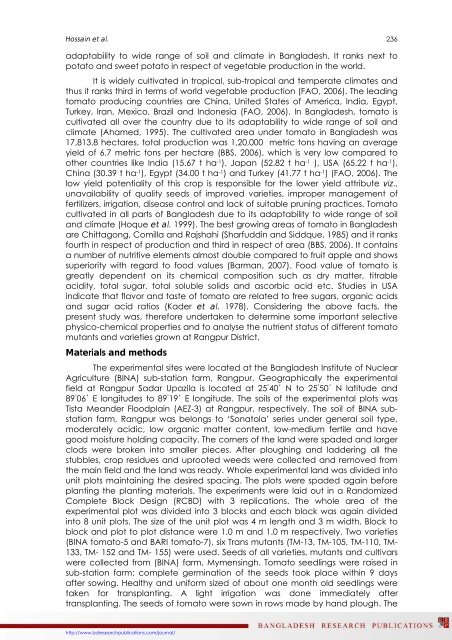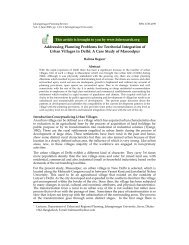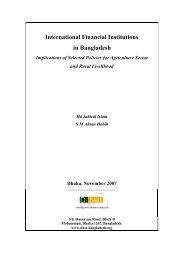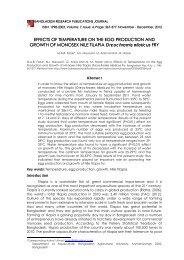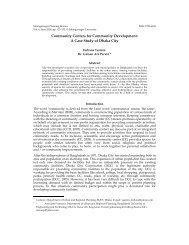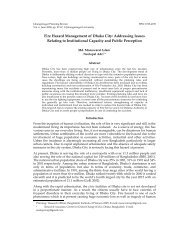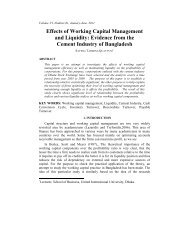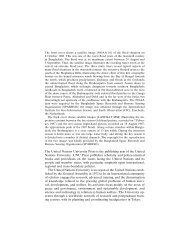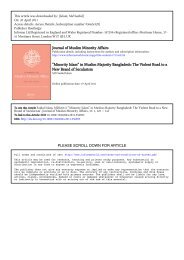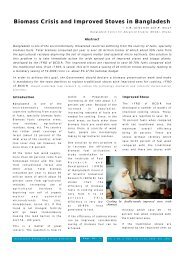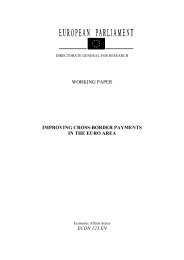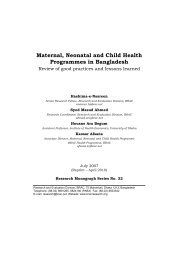Assessment of Physicochemical Properties of Tomato Genotypes.pdf
Assessment of Physicochemical Properties of Tomato Genotypes.pdf
Assessment of Physicochemical Properties of Tomato Genotypes.pdf
Create successful ePaper yourself
Turn your PDF publications into a flip-book with our unique Google optimized e-Paper software.
Hossain et al.236adaptability to wide range <strong>of</strong> soil and climate in Bangladesh. It ranks next topotato and sweet potato in respect <strong>of</strong> vegetable production in the world.It is widely cultivated in tropical, sub-tropical and temperate climates andthus it ranks third in terms <strong>of</strong> world vegetable production (FAO, 2006). The leadingtomato producing countries are China, United States <strong>of</strong> America, India, Egypt,Turkey, Iran, Mexico, Brazil and Indonesia (FAO, 2006). In Bangladesh, tomato iscultivated all over the country due to its adaptability to wide range <strong>of</strong> soil andclimate (Ahamed, 1995). The cultivated area under tomato in Bangladesh was17,813.8 hectares, total production was 1,20,000 metric tons having an averageyield <strong>of</strong> 6.7 metric tons per hectare (BBS, 2006), which is very low compared toother countries like India (15.67 t ha -1 ), Japan (52.82 t ha -1 ), USA (65.22 t ha -1 ),China (30.39 t ha -1 ), Egypt (34.00 t ha -1 ) and Turkey (41.77 t ha -1 ) (FAO, 2006). Thelow yield potentiality <strong>of</strong> this crop is responsible for the lower yield attribute viz.,unavailability <strong>of</strong> quality seeds <strong>of</strong> improved varieties, improper management <strong>of</strong>fertilizers, irrigation, disease control and lack <strong>of</strong> suitable pruning practices. <strong>Tomato</strong>cultivated in all parts <strong>of</strong> Bangladesh due to its adaptability to wide range <strong>of</strong> soiland climate (Hoque et al. 1999). The best growing areas <strong>of</strong> tomato in Bangladeshare Chittagong, Comilla and Rajshahi (Sharfuddin and Siddque, 1985) and it ranksfourth in respect <strong>of</strong> production and third in respect <strong>of</strong> area (BBS, 2006). It containsa number <strong>of</strong> nutritive elements almost double compared to fruit apple and showssuperiority with regard to food values (Barman, 2007). Food value <strong>of</strong> tomato isgreatly dependent on its chemical composition such as dry matter, titrableacidity, total sugar, total soluble solids and ascorbic acid etc. Studies in USAindicate that flavor and taste <strong>of</strong> tomato are related to free sugars, organic acidsand sugar acid ratios (Kader et al. 1978). Considering the above facts, thepresent study was, therefore undertaken to determine some important selectivephysico-chemical properties and to analyse the nutrient status <strong>of</strong> different tomatomutants and varieties grown at Rangpur District.Materials and methodsThe experimental sites were located at the Bangladesh Institute <strong>of</strong> NuclearAgriculture (BINA) sub-station farm, Rangpur. Geographically the experimentalfield at Rangpur Sadar Upazila is located at 25˚40΄ N to 25˚50΄ N latitude and89˚06΄ E longitudes to 89˚19΄ E longitude. The soils <strong>of</strong> the experimental plots wasTista Meander Floodplain (AEZ-3) at Rangpur, respectively. The soil <strong>of</strong> BINA substationfarm, Rangpur was belongs to ‘Sonatola’ series under general soil type,moderately acidic, low organic matter content, low-medium fertile and havegood moisture holding capacity. The corners <strong>of</strong> the land were spaded and largerclods were broken into smaller pieces. After ploughing and laddering all thestubbles, crop residues and uprooted weeds were collected and removed fromthe main field and the land was ready. Whole experimental land was divided intounit plots maintaining the desired spacing. The plots were spaded again beforeplanting the planting materials. The experiments were laid out in a RandomizedComplete Block Design (RCBD) with 3 replications. The whole area <strong>of</strong> theexperimental plot was divided into 3 blocks and each block was again dividedinto 8 unit plots. The size <strong>of</strong> the unit plot was 4 m length and 3 m width. Block toblock and plot to plot distance were 1.0 m and 1.0 m respectively. Two varieties(BINA tomato-5 and BARI tomato-7), six Trans mutants (TM-13, TM-105, TM-110, TM-133, TM- 152 and TM- 155) were used. Seeds <strong>of</strong> all varieties, mutants and cultivarswere collected from (BINA) farm, Mymensingh. <strong>Tomato</strong> seedlings were raised insub-station farm; complete germination <strong>of</strong> the seeds took place within 9 daysafter sowing. Healthy and uniform sized <strong>of</strong> about one month old seedlings weretaken for transplanting. A light irrigation was done immediately aftertransplanting. The seeds <strong>of</strong> tomato were sown in rows made by hand plough. Thehttp://www.bdresearchpublications.com/journal/


